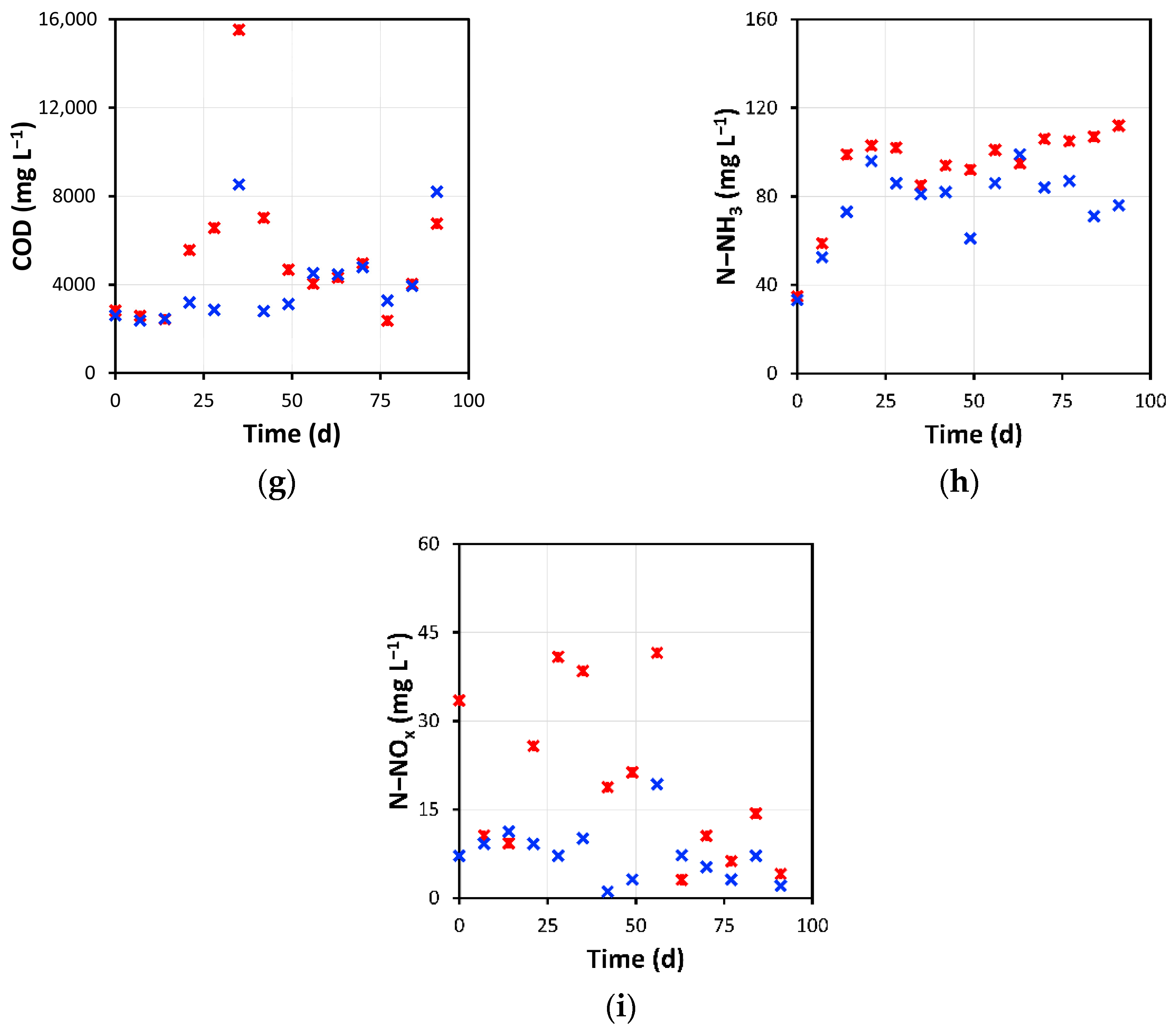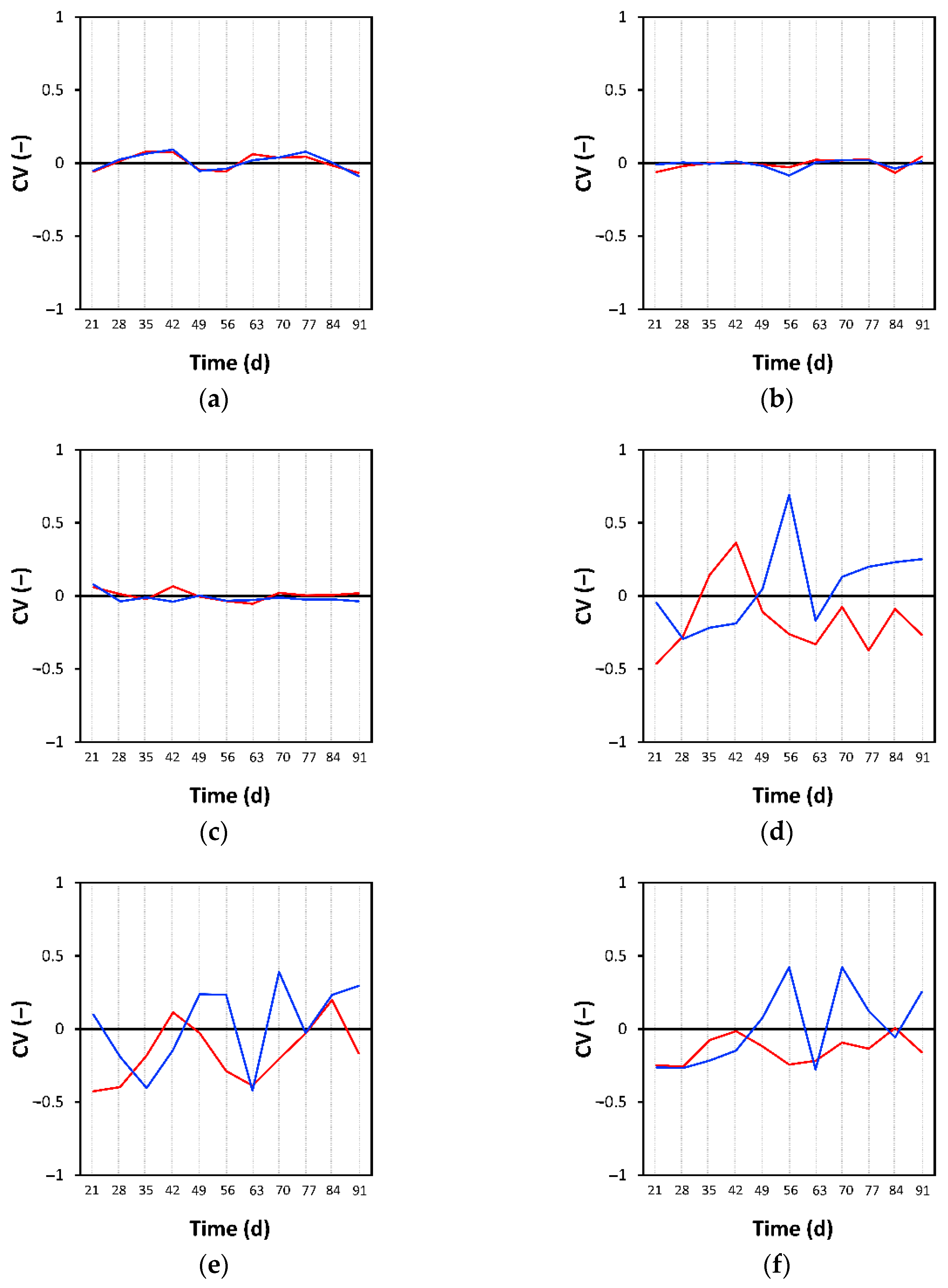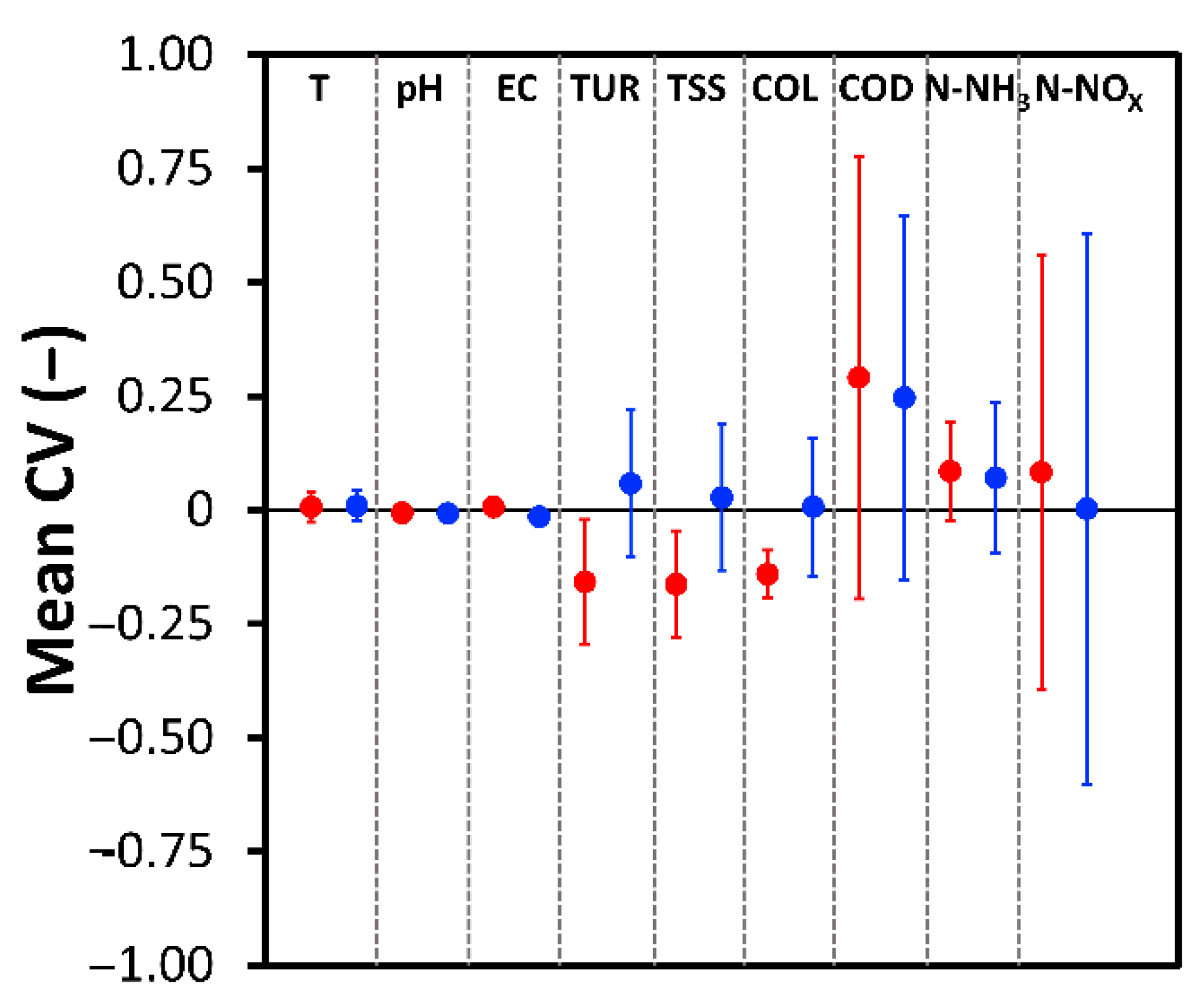Influence of Cellulose on the Anoxic Treatment of Domestic Wastewater in Septic Tanks: Statistical Analysis of the Chemical and Physico-Chemical Parameters
Abstract
1. Introduction
2. Materials and Methods
2.1. Preparation of Synthetic Wastewater
2.2. Experimental Set-Up
2.3. Analytical Methods
2.4. Data Processing and Statistical Analysis
3. Results and Discussion
3.1. Monitoring of the Chemical and Physico-Chemical Parameters
3.2. Correlation Analysis
3.3. Statistical Analysis of the Trends
4. Conclusions
Supplementary Materials
Author Contributions
Funding
Institutional Review Board Statement
Informed Consent Statement
Data Availability Statement
Acknowledgments
Conflicts of Interest
Nomenclature
References
- Zhao, W.; Bi, X.; Peng, Y.; Bai, M. Research advances of the phosphorus-accumulating organisms of Candidatus Accumulibacter, Dechloromonas and Tetrasphaera: Metabolic mechanisms, applications and influencing factors. Chemosphere 2022, 307, 135675. [Google Scholar] [CrossRef]
- Zhao, W.; Bi, X.; Bai, M.; Wang, Y. Research advances of ammonia oxidation microorganisms in wastewater: Metabolic characteristics, microbial community, influencing factors and process applications. Bioprocess Biosyst. Eng. 2023, 46, 1–13. [Google Scholar] [CrossRef] [PubMed]
- Kumar, S.; Dutta, V. Constructed wetland microcosms as sustainable technology for domestic wastewater treatment: An overview. Environ. Sci. Pollut. Res. 2019, 26, 11662–11673. [Google Scholar] [CrossRef]
- Espíndola, S.P.; Pronk, M.; Zlopasa, J.; Picken, S.J.; van Loosdrecht, M.C. Nanocellulose recovery from domestic wastewater. J. Clean. Prod. 2021, 280, 124507. [Google Scholar] [CrossRef]
- Chen, H. Biotechnology of Lignocellulose; Springer: Dordrecht, The Netherlands, 2014; ISBN 978-94-007-6897-0. [Google Scholar]
- Crutchik, D.; Frison, N.; Eusebi, A.L.; Fatone, F. Biorefinery of Cellulosic Primary Sludge towards Targeted Short Chain Fatty Acids, Phosphorus and Methane Recovery. Water Res. 2018, 136, 112–119. [Google Scholar] [CrossRef] [PubMed]
- Li, S.; Wu, Z.; Liu, G. Degradation Kinetics of Toilet Paper Fiber during Wastewater Treatment: Effects of Solid Retention Time and Microbial Community. Chemosphere 2019, 225, 915–926. [Google Scholar] [CrossRef]
- Chen, R.; Nie, Y.; Kato, H.; Wu, J.; Utashiro, T.; Lu, J.; Yue, S.; Jiang, H.; Zhang, L.; Li, Y.-Y. Methanogenic Degradation of Toilet-Paper Cellulose upon Sewage Treatment in an Anaerobic Membrane Bioreactor at Room Temperature. Bioresour. Technol. 2017, 228, 69–76. [Google Scholar] [CrossRef] [PubMed]
- Ruiken, C.J.; Breuer, G.; Klaversma, E.; Santiago, T.; van Loosdrecht, M.C.M. Sieving Wastewater—Cellulose Recovery, Economic and Energy Evaluation. Water Res. 2013, 47, 43–48. [Google Scholar] [CrossRef]
- Wiśniowska, E.; Kowalczyk, M. Recovery of Cellulose, Extracellular Polymeric Substances and Microplastics from Sewage Sludge: A Review. Energies 2022, 15, 7744. [Google Scholar] [CrossRef]
- Rusten, B.; Rathnaweera, S.S.; Rismyhr, E.; Sahu, A.K.; Ntiako, J. Rotating Belt Sieves for Primary Treatment, Chemically Enhanced Primary Treatment and Secondary Solids Separation. Water Sci. Technol. 2017, 75, 2598–2606. [Google Scholar] [CrossRef]
- Afonso, M.L.; Dinis-Almeida, M.; Fael, C.S. Study of the Porous Asphalt Performance with Cellulosic Fibres. Constr. Build. Mater. 2017, 135, 104–111. [Google Scholar] [CrossRef]
- Bohra, V.; Ahamad, K.U.; Kela, A.; Vaghela, G.; Sharma, A.; Deka, B.J. Energy and Resources Recovery from Wastewater Treatment Systems. In Clean Energy and Resource Recovery; Elsevier: Amsterdam, The Netherlands, 2022; pp. 17–36. [Google Scholar]
- Benstoem, F.; Becker, G.; Firk, J.; Kaless, M.; Wuest, D.; Pinnekamp, J.; Kruse, A. Elimination of Micropollutants by Activated Carbon Produced from Fibers Taken from Wastewater Screenings Using Hydrothermal Carbonization. J. Environ. Manag. 2018, 211, 278–286. [Google Scholar] [CrossRef] [PubMed]
- Libardi, N.; Vandenberghe, L.P.D.S.; Vásquez, Z.S.; Tanobe, V.; de Carvalho, J.C.; Soccol, C.R. A Non-Waste Strategy for Enzymatic Hydrolysis of Cellulose Recovered from Domestic Wastewater. Environ. Technol. 2022, 43, 1503–1512. [Google Scholar] [CrossRef] [PubMed]
- Ballesteros, I.; Duque, A.; Negro, M.J.; Coll, C.; Latorre-Sánchez, M.; Hereza, J.; Iglesias, R. Valorisation of cellulosic rejections from wastewater treatment plants through sugar production. J. Environ. Manag. 2022, 312, 114931. [Google Scholar] [CrossRef] [PubMed]
- Bugajski, P.; Chmielowski, K.; Kaczor, G. Optimizing the Percentage of Sewage from Septic Tanks for Stable Operation of a Wastewater Treatment Plant. Pol. J. Environ. Stud. 2016, 25, 1421–1425. [Google Scholar] [CrossRef]
- Schaider, L.A.; Rodgers, K.M.; Rudel, R.A. Review of Organic Wastewater Compound Concentrations and Removal in Onsite Wastewater Treatment Systems. Environ. Sci. Technol. 2017, 51, 7304–7317. [Google Scholar] [CrossRef]
- Butler, D.; Payne, J. Septic Tanks: Problems and Practice. Build. Environ. 1995, 30, 419–425. [Google Scholar] [CrossRef]
- Shaw, K.; Dorea, C.C. Biodegradation Mechanisms and Functional Microbiology in Conventional Septic Tanks: A Systematic Review and Meta-Analysis. Environ. Sci. 2021, 7, 144–155. [Google Scholar] [CrossRef]
- Nasr, F.A.; Mikhaeil, B. Treatment of Domestic Wastewater Using Conventional and Baffled Septic Tanks. Environ. Technol. 2013, 34, 2337–2343. [Google Scholar] [CrossRef]
- Krzyk, M.; Drev, D. Septic Tanks as Small Municipal Sewage Treatment Plants. In Advanced Technologies, Systems, and Applications VII; Springer: Berlin/Heidelberg, Germany, 2023; pp. 147–153. [Google Scholar]
- Akyol, Ç.; Foglia, A.; Ozbayram, E.G.; Frison, N.; Katsou, E.; Eusebi, A.L.; Fatone, F. Validated Innovative Approaches for Energy-Efficient Resource Recovery and Re-Use from Municipal Wastewater: From Anaerobic Treatment Systems to a Biorefinery Concept. Crit. Rev. Environ. Sci. Technol. 2020, 50, 869–902. [Google Scholar] [CrossRef]
- PVK Prague Waterworks and Sewerage: Everything about Water/Drinking Water (In Czech). Available online: https://www.pvk.cz/vse-o-vode/pitna-voda/ (accessed on 14 March 2023).
- Liu, R.; Li, Y.; Zhang, M.; Hao, X.; Liu, J. Review on the Fate and Recovery of Cellulose in Wastewater Treatment. Resour. Conserv. Recycl. 2022, 184, 106354. [Google Scholar] [CrossRef]
- Ahmed, A.S.; Bahreini, G.; Ho, D.; Sridhar, G.; Gupta, M.; Wessels, C.; Marcelis, P.; Elbeshbishy, E.; Rosso, D.; Santoro, D.; et al. Fate of cellulose in primary and secondary treatment at municipal water resource recovery facilities. Water Environ. Res. 2019, 91, 1479–1489. [Google Scholar] [CrossRef] [PubMed]
- HC Method 8038—Nitrogen Ammonia (ed. 9). Available online: https://www.hach.com/resources/water-analysis-handbook (accessed on 15 March 2023).
- HC Method 8171—Nitrate, MR (ed. 9). Available online: https://www.hach.com/resources/water-analysis-handbook (accessed on 15 March 2023).
- HC Method 8507—Nitrite (ed. 11). Available online: https://www.hach.com/resources/water-analysis-handbook (accessed on 15 March 2023).
- HC Method 8025—Color, True and Apparent, LR (ed. 4). Available online: https://www.hach.com/resources/water-analysis-handbook (accessed on 15 March 2023).
- HC Method 8006—Suspended Solids (ed. 9). Available online: https://www.hach.com/resources/water-analysis-handbook (accessed on 15 March 2023).
- Poznyak, T.I.; Chairez Oria, I.; Poznyak, A.S. Biodegradation. In Ozonation and Biodegradation in Environmental Engineering; Elsevier: Amsterdam, The Netherlands, 2019; pp. 353–388. [Google Scholar]
- Fersi, M.; Mbarki, K.; Gargouri, K.; Mechichi, T.; Hachicha, R. Assessment of Organic Matter Biodegradation and Physico-Chemical Parameters Variation during Co-Composting of Lignocellulosic Wastes with Trametes Trogii Inoculation. Environ. Eng. Res. 2019, 24, 670–679. [Google Scholar] [CrossRef]
- Alisawi, H.A.O. Performance of Wastewater Treatment during Variable Temperature. Appl. Water Sci. 2020, 10, 89. [Google Scholar] [CrossRef]
- Cisterna-Osorio, P.; Lazcano-Castro, V.; Silva-Vasquez, G.; Llanos-Baeza, M.; Fuentes-Ortega, I. Innovative Effluent Capture and Evacuation Device That Increases COD Removal Efficiency in Subsurface Flow Wetlands. Processes 2019, 7, 418. [Google Scholar] [CrossRef]
- Vítězová, M.; Kohoutová, A.; Vítěz, T.; Hanišáková, N.; Kushkevych, I. Methanogenic microorganisms in industrial wastewater anaerobic treatment. Processes 2020, 8, 1546. [Google Scholar] [CrossRef]
- Le Bonté, S.; Pons, M.-N.; Potier, O.; Rocklin, P. Relation Between Conductivity and Ion Content in Urban Wastewater. Rev. Des. Sci. De L’eau 2008, 21, 429–438. [Google Scholar] [CrossRef]
- Kim, H.; Yi, J.-Y.; Kim, B.-G.; Song, J.E.; Jeong, H.-J.; Kim, H.R. Development of Cellulose-Based Conductive Fabrics with Electrical Conductivity and Flexibility. PLoS ONE 2020, 15, e0233952. [Google Scholar] [CrossRef]
- Örmeci, B. Development of an Improved Synthetic Sludge: A Possible Surrogate for Studying Activated Sludge Dewatering Characteristics. Water Res. 2000, 34, 1069–1078. [Google Scholar] [CrossRef]
- Akyol, Ç.; Eusebi, A.L.; Cipolletta, G.; Bruni, C.; Foglia, A.; Giosuè, C.; Frison, N.; Tittarelli, F.; Canestrari, F.; Fatone, F. Cellulosic Materials Recovery from Municipal Wastewater: From Treatment Plants to the Market. In Clean Energy and Resource Recovery; Elsevier: Amsterdam, The Netherlands, 2022; pp. 125–136. [Google Scholar]
- Almomani, F. Field Study Comparing the Effect of Hydraulic Mixing on Septic Tank Performance and Sludge Accumulation. Environ. Technol. 2016, 37, 521–534. [Google Scholar] [CrossRef]
- Yousefifar, A.; Baroutian, S.; Farid, M.M.; Gapes, D.J.; Young, B.R. Hydrothermal Processing of Cellulose: A Comparison between Oxidative and Non-Oxidative Processes. Bioresour. Technol. 2017, 226, 229–237. [Google Scholar] [CrossRef] [PubMed]
- Ray, H.; Perreault, F.; Boyer, T.H. Ammonia Recovery and Fouling Mitigation of Hydrolyzed Human Urine Treated by Nanofiltration and Reverse Osmosis. Environ. Sci. 2022, 8, 429–442. [Google Scholar] [CrossRef]
- Ying, L.; Ai-jun, G.; Jing, Z. Study of Treating High Ammonia-N Domestic Wastewater with CASS Process. Procedia. Environ. Sci. 2011, 11, 858–863. [Google Scholar] [CrossRef]
- Stefanakis, A.; Akratos, C.S.; Tsihrintzis, V.A. Treatment Processes in VFCWs. In Vertical Flow Constructed Wetlands; Elsevier: Amsterdam, The Netherlands, 2014; pp. 57–84. [Google Scholar]
- Gobler, C.J.; Waugh, S.; Asato, C.; Clyde, P.M.; Nyer, S.C.; Graffam, M.; Brownawell, B.; Venkatesan, A.K.; Goleski, J.A.; Price, R.E.; et al. Removing 80%–90% of Nitrogen and Organic Contaminants with Three Distinct Passive, Lignocellulose-Based on-Site Septic Systems Receiving Municipal and Residential Wastewater. Ecol. Eng. 2021, 161, 106157. [Google Scholar] [CrossRef]
- Larsen, T.A.; Udert, K.M.; Lienert, J. Source Separation and Decentralization for Wastewater Management; IWA Publishing: London, UK, 2013; ISBN 9781780401072. [Google Scholar]






| Parameter | CWW | NCWW |
|---|---|---|
| COD [mg L−1] | 2827 | 2605 |
| N-NH3 [mg L−1] | 34.8 | 33.2 |
| N-NO3− [mg L−1] | 33 | 7 |
| N-NO2− [mg L−1] | 0.49 | 0.16 |
| TUR [NTU] | 941 | 307 |
| TSS [mg L−1] | 842 | 501 |
| COL [° Pt-Co] | 8800 | 8900 |
| pH [-] | 7.9 | 8.1 |
| EC [µS cm−1] | 2300 | 2090 |
Disclaimer/Publisher’s Note: The statements, opinions and data contained in all publications are solely those of the individual author(s) and contributor(s) and not of MDPI and/or the editor(s). MDPI and/or the editor(s) disclaim responsibility for any injury to people or property resulting from any ideas, methods, instructions or products referred to in the content. |
© 2023 by the authors. Licensee MDPI, Basel, Switzerland. This article is an open access article distributed under the terms and conditions of the Creative Commons Attribution (CC BY) license (https://creativecommons.org/licenses/by/4.0/).
Share and Cite
Djordjevićová, D.; Carnevale Miino, M.; Raček, J.; Hlavínek, P.; Chorazy, T.; Rajaković-Ognjanović, V.; Cvijetić, N. Influence of Cellulose on the Anoxic Treatment of Domestic Wastewater in Septic Tanks: Statistical Analysis of the Chemical and Physico-Chemical Parameters. Sustainability 2023, 15, 7990. https://doi.org/10.3390/su15107990
Djordjevićová D, Carnevale Miino M, Raček J, Hlavínek P, Chorazy T, Rajaković-Ognjanović V, Cvijetić N. Influence of Cellulose on the Anoxic Treatment of Domestic Wastewater in Septic Tanks: Statistical Analysis of the Chemical and Physico-Chemical Parameters. Sustainability. 2023; 15(10):7990. https://doi.org/10.3390/su15107990
Chicago/Turabian StyleDjordjevićová, Denisa, Marco Carnevale Miino, Jakub Raček, Petr Hlavínek, Tomáš Chorazy, Vladana Rajaković-Ognjanović, and Nada Cvijetić. 2023. "Influence of Cellulose on the Anoxic Treatment of Domestic Wastewater in Septic Tanks: Statistical Analysis of the Chemical and Physico-Chemical Parameters" Sustainability 15, no. 10: 7990. https://doi.org/10.3390/su15107990
APA StyleDjordjevićová, D., Carnevale Miino, M., Raček, J., Hlavínek, P., Chorazy, T., Rajaković-Ognjanović, V., & Cvijetić, N. (2023). Influence of Cellulose on the Anoxic Treatment of Domestic Wastewater in Septic Tanks: Statistical Analysis of the Chemical and Physico-Chemical Parameters. Sustainability, 15(10), 7990. https://doi.org/10.3390/su15107990








